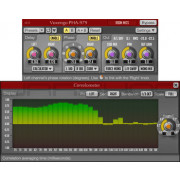

Their frequency range is 35 Hz - 16 kHz (-10dB) and the frequency response is (☓ dB) from 45 Hz - 12 kHz. There were some comments in this thread indicating that Voxengo's Deconvolver may produce a better result.
#Voxengo deconvolver capture pedals how to
()Īnd, there's a help file that's accessible from within Voxengo Deconvolver which explains how to use that utility. However, I did find this article by SOS which describes precisely what to do using ReaVerb.
#Voxengo deconvolver capture pedals manual
There is no explanation of how to do this in either manual or the wiki. And, I have an opportunity because this December I'll be taking my PA system in to broadcast the sound of the organ to the outside of the church. I've been wanting to do this for a long time, but now that I've joined the choir I can get permission from the music director. I want to record the reverb IR of my church. (I understand that once the IR is generated you can/should trim the head to suit your desires i'm just talking about the deconvolution stage and wondering how it works - i would have assumed that it would need to be precisely aligned with the sine sweep.) It all seems to work, so i guess it works :-), but i always have this nagging worry that i'm missing something.

Maybe there's 10ms before the sweep starts, maybe there's 2 seconds, depending on how I lined up the clip when i presed "record".įrom that lack of instruction, I assume that it doesn't matter, and that the deconvolution algorithm can either figure it out or it doesn't even need to know. wav file that I generated with, say, the voxengo app, the deconvolution instructions never include any precise direction on how to align the left edge of the resulting room-response recording before runnin the deconvolution. I'm always confused about how the deconvolution algorithm knows when the test tone starts: meaning, if I record a space remotely, using a stock sine sweep. My impression is also that the (free) voxengo deconvolver is "better" than the Reaverb one, but i haven't done any head-to-heads. This is my understanding/memory/expectation as well. (In any case, it would be a good idea to eliminate any extraneous noises as much as possible when doing the IR capture recording.)

However, I have a vague memory that with the sine sweep method the effect of undesired noise during the recording may be mitigated. ReaVerb can deconvolve sine sweeps, but my loose information is that the voxengo program might do a better job.Īnd of course ReaVerb can use the results as convolution reaverb. Your method of recording with a handheld device probably lends itself to the simpler method so you don't have to tote a speaker around. When you use the Voxengo program, it generates sine sweeps and then "deconvolves" those for you, but you need a loudspeaker with you to do that. More info in the grey box at the end of this article: You just edit to the end of the spike of the noise, as Judders said. You're actually just creating the impulse file directly that way: the audio file is a recording of the instant spike of broadband noise (the pop sound) fading away. When you use balloons and starter pistols and such, you don't need to deconvolve.


 0 kommentar(er)
0 kommentar(er)
